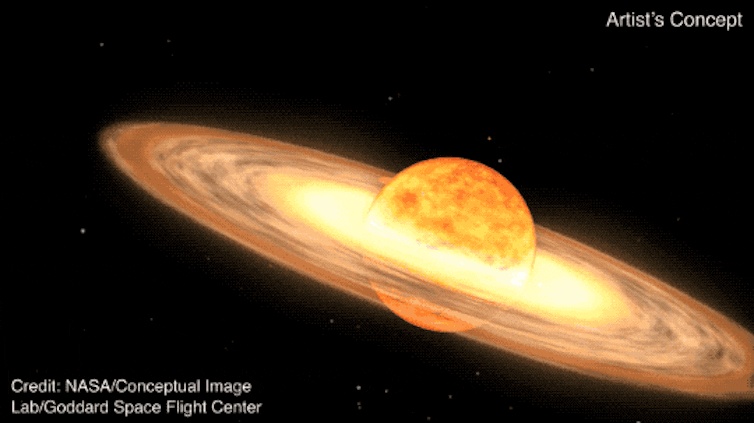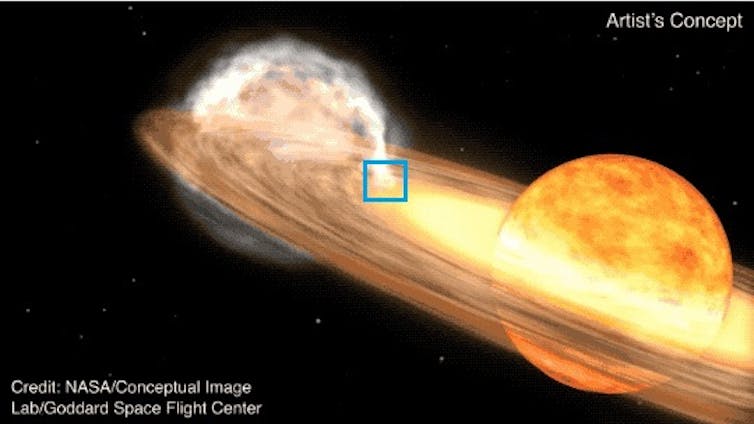Imminent stellar explosion visible to the naked eye

There are spectacular astronomical events that we are lucky enough to see more than once in our lives, such as a total eclipse of the Sun or the glowing trail of a superbolide in the night sky, courtesy of majestic comets. But a much more exceptional event is about to happen in the skies, one that could even start tonight. This is a stellar explosion, a new star that can be seen with the naked eye.
NASA has announced that this astronomical phenomenon will be observable with the naked eye for several days in the near future.

NASA Goddard Space Flight CenterCC BY-SA
A new (and ephemeral) point of light in the sky
This rare but spectacular nova event is a sudden increase in luminosity in a specific region of space. From Earth it will look as if a star has suddenly appeared. It will appear in the small constellation Corona Borealis, about 3,000 light-years from Earth.
Several of the constellation’s brightest stars are home to planetary systems, including Negolu, a Jupiter-like planet whose atmosphere has been found to contain water vapor. It is in this part of the sky that a new point of light will appear, the result of a stellar explosion in a binary system formed by a white dwarf and a red giant.

How and when do these nova-type explosions occur? What will this new object look like in the sky?
Thermonuclear explosion at a distance of 3000 light years from us
A new star does not form and is not a “stellar death” (as happens with supernovae). The increase in brightness that we will be able to observe will be the result of thermonuclear reactions that are triggered in a binary system of two stars orbiting each other: the T Coronae Borealis (T Cr) system.
One of them is a white dwarf (called T CrB) with a mass similar to the Sun and a diameter about 100 times smaller, which causes an intense gravitational field. Its companion star, the red giant T CrA, is losing matter (mostly hydrogen) due to T CrB’s powerful gravity. And hydrogen is gradually deposited on the surface of the white dwarf.

POT
As a consequence, the concentration of hydrogen in the white dwarf gradually increases, and the pressure and temperature increase until they reach their limit. It then explodes in a colossal thermonuclear explosion, similar to the explosions of Earth’s thermonuclear bombs.
After this turbulent episode, the dwarf star will return to its original state, it will again collect hydrogen from its companion, and so on, until the nova repeats itself in about 80 years. This is why it is so difficult to witness this event twice in your life.

Recurrent or periodic novae
We usually cannot predict with certainty when such a stellar explosion will occur. However, there is a small group of binary white dwarf systems that periodically generate new ones, that is, they repeat in cycles of several decades. We’re talking about recurring or occasional new ones, and luckily T CrB belongs to that select club.
In addition to knowing the frequency with which a white dwarf fills to capacity, researchers have other indications that this nova event is inevitable. Thus, according to NASA scientist William J. Cook, the dimming of a white dwarf during the previous period of one year is a clear sign of the proximity of a stellar explosion. YT CrB began to darken in March 2023.
So what exactly will we see in the night sky, perhaps one night this summer?
Appearance similar to the North Star
When cataloging bright objects in the sky, such as planets or stars, astronomers use a well-known parameter called apparent magnitude.
Essentially, it has to do with the brightness of a star in the night sky and depends on its luminosity and distance from us. The lower the apparent magnitude, the brighter the object will be in the sky.
So, for example, the apparent magnitude of the full Moon is -12.6, the star Sirius (the brightest in the night sky) is -1.46, and the North Star returns a value of +2.

The T CrB star system has an apparent magnitude of +10, but when the next nova explosion occurs, its visibility will increase significantly to a value of +2, comparable to the brightness of Polaris.
It is at that moment that we will be able to contemplate this new “star” with the naked eye for several days, without the aid of any optical instruments, before it fades again and disappears, perhaps for another 80 years.
We will witness a unique astronomical event: the thermonuclear explosion of a white dwarf. For those who don’t know what’s going on there, an ephemeral star will be born.
